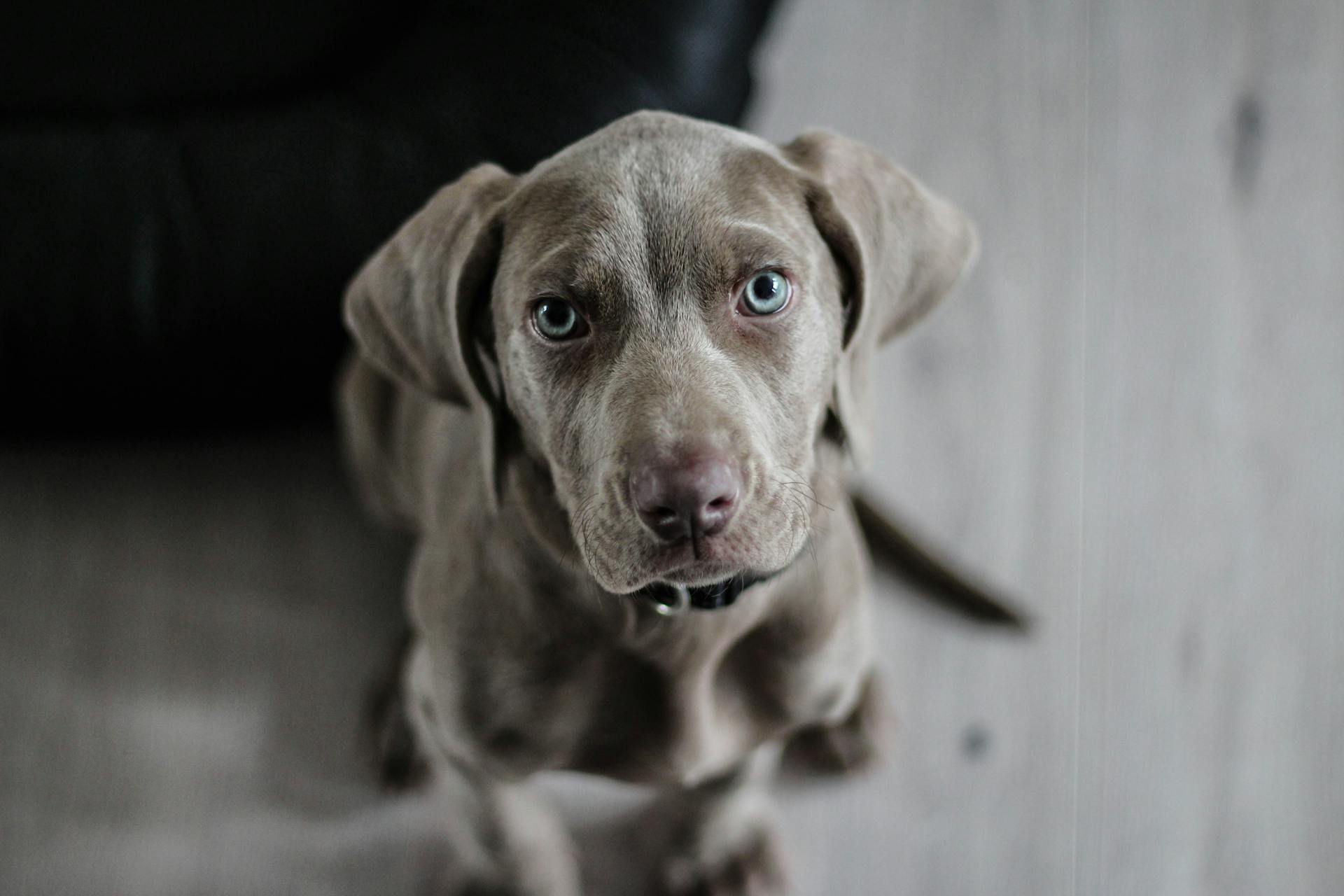
Dogs fear of storms is a common phenomenon that affects many pets. According to research, up to 50% of dogs exhibit storm anxiety.
Dogs may associate loud thunderstorms with past traumatic experiences, such as being separated from their owners or experiencing loud noises. This can lead to a deep-seated fear that's hard to overcome.
One key factor contributing to a dog's fear of storms is their keen sense of hearing. Dogs can pick up on sounds that are too faint for humans to detect, making the loud thunder and crackling lightning even more terrifying.
Understanding Dog Storm Phobia
Dogs can be afraid of storms due to the loud noise, which can startle them and make them feel afraid. This noise can be particularly frightening because it's unpredictable and has no tangible visual component.
A sudden loud noise can present a potential threat to dogs, who thrive on predictability and are comforted by knowing exactly what to expect. This is especially concerning for them if there is nothing to attribute the sound to.
About 49% of dogs show a significant fear response to firework noise, which is similar to the noise of a thunderstorm. This suggests that many dogs are already prone to noise phobias.
Dogs may also be sensitive to the static electricity in the air during a storm, which can cause little shocks when they touch their nose to surfaces. This sensory experience can be another reason your dog demonstrates fear during a thunderstorm.
Barometric pressure changes, lightning, and static electricity in the air can all contribute to a dog's storm phobia. These factors work together to create a complex and frightening experience for dogs.
Here are some common signs of storm phobia in dogs:
- Loud whining or barking
- Pacing or restlessness
- Shaking or trembling
- Hiding or seeking a safe place
- Increased salivary cortisol levels
Recognizing Signs of Fear
Dogs display their fear in various ways, making it crucial to be aware of the signs to provide them with comfort and reassurance.
Ears pinned back and tail down between legs are common indicators of a dog's fear. I've seen my friend's dog exhibit this behavior during thunderstorms, and it's always a good sign to pay attention.
Panting, lip-licking, and yawning are also telltale signs of a dog's nervousness. Yawning, in particular, is a complex behavior known as an appeasement gesture, signaling that your dog is feeling anxious but not aggressive.
A dog's mouth and muzzle action can reveal their fear. If your pet is yawning, licking their lips, or panting more than usual, it's likely due to bad weather.
Here are some specific signs to look out for in your dog's behavior during bad weather:
- Ears pinned back
- Tail down between legs
- Panting, lip-licking, and yawning
- Vocalizing
- Pacing and shaking
These signs can indicate that your dog is experiencing storm anxiety, which can worsen with every storm if not addressed.
How to Soothe
So you want to know how to soothe your dog during a storm? First, it's essential to remember that your dog's fear is real and warranted, so don't ignore their behavior. Creating a safe place for them to retreat can be a great start, like an enclosed space with some soundproofing to muffle the storm sounds.
To help your dog feel more secure, try to remain calm yourself – your pet is very attuned to your behavior. Speak to your dog in calm tones and don't be overly attentive, as this can communicate concern. Instead, try to behave as normally and consistently as possible during the storm.
You can also provide distracting sounds to help block out the thunder, like turning on the television, radio, or a white noise machine. Classical music, in particular, can be very calming for dogs. Just be sure to keep the volume low, as loud noises can further increase your pet's stress.
If your dog is still feeling anxious, try distracting them with engaging activities, like their favorite toys or games. A gentle massage can also be a great way to calm them down. Remember, every dog is different, so it may take some trial and error to find the right combination of remedies that work for your pet.
Here are some additional tips to help soothe your dog during a storm:
- Create a safe space with soundproofing
- Remain calm and speak in a calm tone
- Provide distracting sounds, like classical music or white noise
- Engage your dog in activities they enjoy
- Consider using calming formulas with CBD
By following these tips and being patient with your dog, you can help them feel more comfortable and secure during a storm.
Treatment and Prevention
Treatment of storm phobia can be straightforward, but it's not always easy. Bringing your dog indoors during a storm, providing background noise, and offering a safe place can help calm them down. If possible, having the owner present can also make a big difference.
The goal of treatment is to help your dog feel calm and relaxed during a storm. Desensitization and counterconditioning (DS&CC) can be used to achieve this, but it's a complex process that requires intensive follow-up. You can start by playing a CD of storm noises at low volume and giving your dog treats and praise.
If your dog responds to the sound of rain or thunder with fear, DS&CC can be attempted. To do this, start with the least scary stimulus, such as rain, and gradually increase the volume. Move slowly and gradually to sounds that trigger more intense fear, but remember to keep the sessions short and calm.
Desensitization can also be done when there's no storm in the area. Play a recording of thunderstorms at low volume and give your dog treats and praise. Over time, as you gradually increase the volume, the association between storms and fear will be reduced and eventually eliminated.
If your dog's storm phobia is severe, antidepressant/antianxiety medications may be necessary. Selective serotonin reuptake inhibitors (SSRIs) and tricyclic antidepressants (TCAs) can be used to decrease overall anxiety. However, treatment should be instituted approximately a month before "storm season" and the dog may need to be weaned off the medication after the season is over.
Here are some general tips to keep in mind:
- Bring your dog indoors during a storm to provide a safe space.
- Provide background noise to help calm your dog down.
- Offer a safe place for your dog to retreat to during a storm.
- Consider using desensitization and counterconditioning (DS&CC) to help your dog feel calm during a storm.
Desensitization and Counterconditioning
Desensitization and counterconditioning (DS&CC) is a technique used to help dogs overcome phobias, including storm phobia. This method involves gradually exposing the dog to the feared stimulus, in this case, storm noises, while associating it with positive experiences.
Start by using a CD of storm noises, beginning with the least scary stimulus, such as rain, and gradually increasing the volume. The goal is to keep the dog calm and relaxed during the session.
Begin each stimulus softly, with a gradual increase in volume, and move slowly to sounds that trigger more intense fear. Sessions should take place daily for 5 to 10 minutes, or as the owner's schedule permits.
The CD should not be played as background noise, playing loudly, as this may worsen the anxiety due to the "flooding" effect. Instead, use it as a tool to help the dog gradually become desensitized to the feared stimulus.
Here's a general outline to follow:
Remember, the key to success is to keep the dog calm and relaxed during the session. With patience and consistency, DS&CC can be an effective tool in helping your dog overcome storm phobia.
Natural Therapies and Medications

If your dog has storm phobia, there are some natural therapies and medications that can help alleviate their anxiety. Essential oils applied to the back of the neck or on a cloth can be a helpful option.
Pheromone spray is another natural remedy that can be used to calm your dog. Tryptophan supplements are also worth considering.
We sometimes use over-the-counter sedatives to help take the edge off, but it's essential to consult with your veterinarian before trying these. Here are some natural therapies and medications you can consider:
- Essential oils applied to the back of the neck or on a cloth
- Pheromone spray
- Tryptophan supplements
Common Misconceptions
Dogs don't just suddenly develop a fear of storms, it's a learned behavior that can be triggered by a combination of genetic predisposition, environmental factors, and past experiences.
Some people believe that dogs are naturally more anxious than other animals, but research suggests that dogs can be just as calm and relaxed as any other pet.
Thunderstorms can be particularly frightening for dogs because of the loud thunder and bright lightning, which can be overwhelming for their sensitive hearing and vision.
Dogs may also associate the stormy weather with previous experiences of being scared or separated from their owners.
Frequently Asked Questions
Why do dogs pant and shake during thunderstorms?
Dogs pant and shake during thunderstorms due to stress and anxiety, which can be triggered by the loud thunder and flashes of lightning. Understanding the causes of this behavior can help you develop effective strategies to calm your dog during future storms.
Sources
- https://todaysveterinarypractice.com/behavior/noise-storm-phobias-anxiety-in-dogs/
- https://www.eastportvet.com/storm-phobia-in-dogs/
- https://www.pawcbd.com/blogs/posts/is-your-dog-afraid-of-thunder-learn-how-you-can-help
- https://k9basics.com/home-remedies-to-calm-a-dog-during-a-storm/
- https://www.humanesociety.org/resources/pets-fear-thunder-loud-noises
Featured Images: pexels.com


